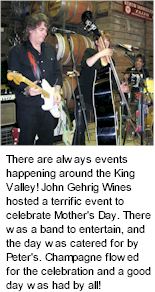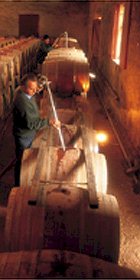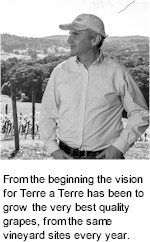| |
|
From Victoria's
Heathcote

Dark red/purple. Lovely intense Shiraz fruit leaps from the glass, berry fruits, spices and clove dominate, brooding with underlying scents of pepper, herbs of provence and classy French oak. The palate is loaded with dark fruited intensity, texture, balance and length of palate. Lush ripe sweet berries are followed by subtle nuances of spice and toasted oak.
|
|
|

|
The idyllic hillsides of Langhe are the most felicitous winegrowing climes in Piedmont
Amongst The Finest Viticultural Precincts In All Italy It has been this way for millennia Alfred Prunotto established a peerless reputation for quality by isolating and retaining the most exquisite sites, his heirloom vineyards continue to outperform. Harvests of Arneis from splendid sites in the communes of Monteu Roero and Montaldo Roero, Monta and Vezza d'Alba, are assembled into an immaculate wine of refined structure, comely bouquet and pristine, engagingly flavourful palate.
|
|
|
|

|
Enter Brokenwood's response to the modern day enthusiasm for finely structured Chardonnay with more balance
Lower Phenolics And Timely Oak Established 1988 on the of brisk altitudes of the Orange uplands Forest Edge Vineyard gives its fruit to a regimen of whole bunches and wild ferments in a mix of new and seasoned French oak, powered by the splendid complexity achieved through indigenous yeasts and lees sediment battonage, its creamy mealyness makes Brokenwood the ideal accompaniement to west coast marron, truffled spatchcock or bugs mornay.
|
|

WHAT MAKES A GREAT VINTAGE FOR HUNTER VALLEY SEMILLON? MOST WOULD SAY ONE WITHOUT FLOODING RAIN, ravaging fires or devastating drought. While this is certainly important, balance in the wine reigns supreme. Mid January always brings with it a slight nervousness, having been battered vintage after vintage with drought and pouring rain, is it any wonder that black cats are avoided and ladders given a wide berth? The magic of Hunter Semillon on display, texture and weight from a wine that sees no oak, only ever released in the finest years, ILR Reserve is a beauty.

INSPIRED BY THE LUSH FRUITINESS OF THE ITALIAN CLASSIC MOSCATO D'ASTI, Gapsted is a blend in name and in style, of the piquant Traminer Musque grape and the wickedly luscious Frontignac Muscato bianco. Traminer is sourced from Whitlands Vineyard, grown to the higher, elevated aspects of Valley King, picked early to retain freshness and lively fruit character. This slightly spritzy Moscato drinks well on its own but also suits a range of lighter desserts such as pannacotta or soft cheese, dried fruits or peach almond recipes.

THE MOUNT RILEY TEAM PRACTISE AN EARTH TO BOTTLE DISCIPLINE OF WINEMAKING AND VITICULTURE, a totally holistic endeavour which can operate around the clock to get the fruit in on time, right at the most perfect point of ripening. What gives Mount Riley estate it's greatest edge however are it's splendid vineyards which yield immaculate harvests of generously flavoured fruit. Mount Riley make the essential Marlborough Sauvignon Blanc, its appeal gains momentum with white wine enthusiasts throughout the world of wine, after every new vintage.

TO THIS DAY, Mount Pleasant continues to preserve the heritage of labels which played a role in the evolution of Australian wine. Slightly bolder in palate structure than it's regional siblings, Philip is the classic style of Hunter Valley Shiraz, a name that's been relied upon for decades. An affable wine, without excessive tannin or alcohol, exhibiting the complexity and inimitable charm of the Hunter. Generous and smooth, articulating earth and spice, dominated by masculine fruit characters. Every release guarantees a splendid Philip, a Shiraz with a tradition of excellence.
|
Redgate Wines is
located in a beautiful part of the Margaret River Wine Region that is very close to the wild coast line where the Indian and Southern Oceans meet
Close by the winery lies Redgate Beach (a favourite spot for both body surfers and fisherman) and a Redgate Road which runs from Redgate Beach to the village of Witchcliffe, there seems to be little in the way of official history in regard to where the Redgate name came from.

Bill Ullinger, the founder and proprietor of Redgate Wines, has passed on his version of how he came to use the name Redgate. Although there is no evidence to suggest that this version of events is anything but the truth, one tends to find that as the sun (and the wine bottle) go down in Margaret River the tales seem to grow ever longer with the shadows.
It would seem that not long after the turn of the last century there was a farmer whose farm was located just inland from what is now Redgate Beach and on what was to become Redgate Road. Now as Margaret River in those days was an extremely long way from any major towns (Perth would have been nearly a two day trip by carriage) there tended to be a relative shortage of places one could obtain an alcoholic beverage.
As the locals who lived around Redgate Beach found getting to the local watering hole a little difficult they decided they needed an alternative. And so the story goes that our friendly farmer, who happened to have a prominent Red Gate at the front of his property, decided that he would operate a spirit still that may not have been legal. Due to the secretive nature of this operation those in know would come to the farm and ask if there was any Red Gate available. Bill, in his wisdom, has deemed it not necessary to tell us the final outcome of this illicit operation, but if the local constabulary were anything like the rest of their Australian colleagues of the day, I'm sure they were always on top of quality control at Redgate.
Moving ahead to 1981 and the Ullinger's first vintage, Bill felt that this story accorded well with what he was trying to establish. That would be a place where all and sundry could drop by and ask for a drop of their favourite beverage in a warm and friendly environment where quality control was a watchword.
Bill Ullinger is the original owner of Redgate Wines, which he established in 1976. A World War II Lancaster pilot, Bill is renowned in the West Australian wine industry as one who speaks his mind whatever the consequences. Bill's colourful language and firm vocal stands on issues he believed in, have become a hallmark, in an industry dominated by powerful major companies.
John Gehrig is
a fourth generation winemaker, a descendant of Victoria's oldest winemaking family which settled in the late 1850s at Barnawartha in North East Victoria
John learned his trade from his father. John spent sixteen years working on the family estate before a three year exposure to commercial and retail business whilst actively pursuing a vineyard investment. He has a passion for wine that stretches over 60 plus years (not giving too much away!) and can tell you many a story about his experiences in the wine industry over that time.

In 1976 John and Elizabeth purchased twenty acres of land at Oxley on the King River and during that year established their first vines. The diversity of this pretty countryside with such a range of viticultural microclimates was an encouragement to settle in the King Valley.
Since 1976 John and Elizabeth have realised their ambitions. Cellar sales commenced in 1981 and fourteen acres are now under vine, producing most of their grape requirements. Their modern family operated winery is designed for a 70 tonne grape crush.
The vineyard is planted to Rhine Riesling, Chardonnay, Chenin Blanc, Sauvignon Blanc, Pinot Noir, Cabernet Sauvignon, Merlot and Muscat and is watered by a trickle irrigation system. A grafting programme has ensured that half of the vines are on their own roots, with the other half grafted onto American root stock to offset the danger of phylloxera infestation.
Between February and May the grapes are harvested. The practical size of the vineyard allows for hand pruning and picking which assists in the production of premium wines. There are certainly a wide variety of quality wines to choose from at John Gehrig. The chosen varietals all suit the climates surrounding the Gehrig vineyards of northeast Victoria, the finished wines exhibit full fruit flavour across the whole range. Enjoy!
The winery is open to the public for sales and tasting seven days per week. A pretty all weather barbeque area on the King River has been established for small winery groups and buses. With prior notice, inspection of the winery can also be arranged. John is now semi retired, and can still be found poking around the salesroom where he's more than happy to have a chat and show you around. His geese and ducks are his new hobby, and if you're lucky to come around feeding time it's a sight not to be missed! John and Elizabeth Gehrig have four children, who have all inherited the love for wine from their parents. Andrew, Jane, Ross and Victoria all share the passion of wine that is now 5 generations old.
Yalumba, Australia's oldest
family owned and operated winery, has a wealth of history and tradition
Yalumba was founded in 1849 by Samuel Smith, British migrant and English brewer, who had brought his family to Angaston seeking a new life. After purchasing a 30-acre parcel of land just beyond the southern-eastern boundary of Angaston, Smith and his son began planting the first vines by moonlight. Samuel named his patch Yalumba, aboriginal for 'all the land around'.

The Yalumba philosophy quietly encourages innovation, experimentation and a visionary outlook in the quest to make great wine. There are literally thousands of rare, eclectic and idiosyncratic grape varieties used to make wine around the world. Yalumba's Vine Propagation Nursery is able to source many of these varieties, performing clonal and varietal selection, which ultimately provides small batches of fruit for Yalumba's Vinnovations label. In order to sustain the formulation of some of Australia's most compelling wines, Yalumba implements an environmental improvement programme that reflects credible environmental stewardship and due diligence.
At Yalumba, no aspect of winegrowing or winemaking is left to chance. For the past 30 years, Yalumba has been able to influence grape quality at its earliest stage. In the 1970s, the winery made a far-sighted decision to establish its own vine nursery. Today the Yalumba Vine Nursery is one of Australia's largest viticultural nurseries, supplying high quality vines to winemakers throughout Australia. Not only does the Nursery provide safe, quality rootstock for established varieties such as Cabernet Sauvignon and Shiraz, it is also a leading supplier of specialised clones such as the Burgundian Pinot Noir and Chardonnay clones in heavy demand by the country's leading winemakers.
In a wine market largely obsessed with single-varietal wines, Yalumba has remained steadfast in its commitment to that most Australian of wine styles, the Cabernet Shiraz blend. Cabernet Shiraz is taken so seriously by Yalumba, that Brian Walsh, Yalumba's Director of Winemaking persuaded the committee of the Adelaide Wine Show to introduce a separate judging class for the style. It's a wine style that is unique to Australia, he says, and plays such an important part in Australia's winemaking history.
As a wine business operating in the rural environment for over 150 years, Yalumba recognises the impact of its activities on its natural surrounds. Yalumba is committed to integrating best environmental practice into its everyday activities to ensure long-term sustainability. In 1999, Yalumba became the first Australian winery to sign up for the Greenhouse Challenge - an initiative dedicated to reducing greenhouse gas emissions. Yalumba's aim is to be recognised as Australia's finest independent wine company. A wine produced by means of environmentally-friendly sustainable processes is increasingly being recognised as being an intrinsic aspect of quality.
The crafting of oak barrels is a proud tradition at Yalumba with a coopering history dating back to the turn of the 20th century. With its own on-site cooperage, Yalumba is the only winery in Australia, and one of a small and select group of wineries in the world, to enjoy this privilege. Oak plays an important part in the winemaking process and Yalumba have the advantage of being able to have full control of the quality of oak used to age their wines. Yalumba imports oak staves from the world's best oak forests in France and America, and then air-dries the oak for many Barossan summers and winters to leach any sappy, bitter characters from the wood. This extended seasoning (as opposed to the more common practice of seasoning the oak for between 18 months and 2 years) imparts rich chocolate mocha characters and adds yet another layer of texture to the wine without masking the fruit flavours.
Terre a Terre
make wines from the cool climate regions of Adelaide's Piccadilly Valley and Wrattonbully on the Limestone Coast.
Xavier Bizot and Lucy Croser both grew up surrounded by passionate winemaking families. In 2005 they launched their boutique wine import business, Terroir Selections. Together they unearthed small, terroir domaines from Europe for importation to Australia. Inspired by the wines they discovered, they purchased a special piece of land in Wrattonbully and planted their first vineyard. From the beginning the vision for Terre à Terre has been to grow the very best quality grapes, from the same vineyard sites every year, and then vinify them using the best of French and Australian wine practices. In addition to Terre à Terre, the couple also grow and make traditional method sparkling wine under the name DAOSA (Dedicated Artisans of South Australia), from their sparkling Chardonnay and Pinot Noir vineyards in Piccadilly Valley.

Terre a Terre's Crayeres vineyard is in the Wrattonbully GI, located just north of Coonawarra and south of Padthaway. Wrattonbully is considered a fairly new wine region of Australia. The first plantings in Wrattonbully date back to 1969, when 11 hectares were planted by the Penders, including 4 hectares of Shiraz, 4 hectares of Cabernet Sauvignon and 4 hectares of Chardonnay. This was followed by John Greenshields, with his Koppamurra Vineyard in 1974, where he planted 4 hectares of Cabernet Sauvignon. This vineyard has since been bought by Tapanappa and re named the Whalebone Vineyard, and is situated just across the road from the Terre a Terre vineyard.
Wrattonbully's vineyards are located east of the Kanawinka Fault, more elevated than the coastal plains vineyards, as well as being on much older limestone and much older soil sediments. The climate is very similar to Bordeaux with heat summations of 1,350 degree days during the growing season.
The climate in the Piccadilly Valley has a long term average of approximately 1,200 degree days during the growing season and the yearly rainfall is approximately 1,100mm. The terroir in the higher, cooler slopes of the Piccadilly Valley makes it ideal for Sparkling wine produced using Methode Traditionnelle.
Bizot vineyard is situated in the heart of Piccadilly Valley, one of the highest vineyards at 500m altitude. The soil is red clay and sandy loams over a 70 million-year-old shale rock formation. The Chardonnay is planted on a north-north east facing slope. Late in 2015, Terre a Terre took over management of one of the oldest vineyards in Adelaide Hills, Charles Chilly Hargrave’s property at Summertown in Piccadilly Valley. The Summertown vineyard is planted on a north south ridge. The 1987 Chardonnay plantings are on a gentle west facing slope, coming from cuttings from The Tiers Vineyard nearby, and have always been cane pruned. The Pinot Noir plantings sit on the top and the very steep eastern flank of the ridge, mostly spur pruned, using various clones through a progression of annual plantings.
Terre a Terre will continue the long established tradition of Chardonnay and Pinot for the Daosa label's sparkling wines. Much of the 1992 Pinot Noir plantings have been converted to cane pruning for optimal control of yields, for a Piccadilly Valley Pinot Noir under the Terre a Terre label. A long family tradition of outstanding fruit and exceptional wines. A wonderful endowment of vineyards from which to draw the finest vintages. A consuming passion for the winemakers art and the realization of a superb range of wines which are second to none. Exciting times ahead!
|